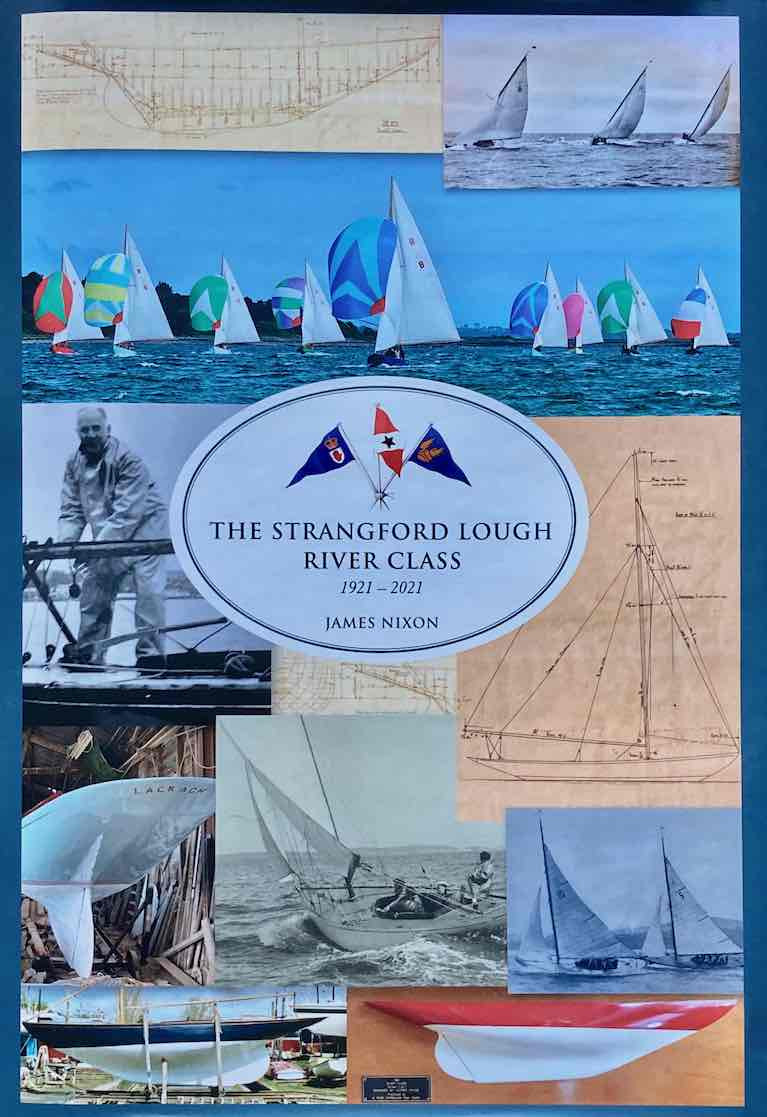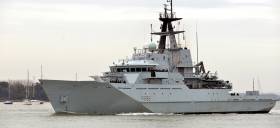Displaying items by tag: River class
Ireland's Centenaries Ashore Are Matched By Sailing Centenaries Afloat
In Ireland, we're living through the Decade of Centenaries in terms of marking conflict-laden historical events and major national happenings ashore. So it says everything about the blissful sense of having a world of our own in sailing that in 2021 and 2022, Ireland-on-the-water is likewise in the midst of celebrating the Centenary of the establishment of two very significant and thriving boat classes, classes which are in such good heart today that you'd assume they came into being in a time of piping peace and powerful prosperity.
You can say a lot about the tumultuous years of 1921 and 1922 in Ireland. But "piping peace and powerful prosperity" is not a phrase that would spring readily to mind. Yet despite the turmoil of the times with Northern Ireland emerging in 1921 and the Irish Free State being recognised in 1922, in 1921 the new Alfred Mylne-designed Bermuda-rigged sloops of the River Class One-Designs of 28ft 3ins LOA started racing on Belfast Lough. And in 1922, racing started on the great lakes of our longest river for the new una-rigged Shannon One Designs - the Sods, as they immediately and inevitably became known.
 Walter Levinge building a Shannon OD on the shores of Lough Ree. In a long association with the class from 1922 onwards, he built sixty of this class in addition to other clinker types such as Water Wags and Mermaids.
Walter Levinge building a Shannon OD on the shores of Lough Ree. In a long association with the class from 1922 onwards, he built sixty of this class in addition to other clinker types such as Water Wags and Mermaids.
Designed by Morgan Giles and built by the best of the local craftsmen, the new 18ft clinker-built boats were a very refined sailing development of the classic Irish lakeboat. Racing was mustard-keen from the start, so all construction was of the permitted minimum weight, resulting in a hull which – when hard on the wind in a bit of a breeze – "would turn round and look at
you".
 From the inauguration of the class, it was realised that hull flexibility was an inevitable factor which had to be accommodated in a successful Shannon One Design
From the inauguration of the class, it was realised that hull flexibility was an inevitable factor which had to be accommodated in a successful Shannon One Design
RIVER CLASS – WEIGHT IS GREAT…….
The Rivers by contrast are of hefty form, and not afraid of carrying a bit of extra weight. In fact, it's the contrast which sailing a River provides - when set against the experience of racing an ultra-light turn-on-a-sixpence modern machine - which is a part of the boats' charm. Though they're no slouches in terms of speed, things may happen slowly when manoeuvring. But they happen very surely too. Collisions can be epic, so thinking well ahead to the next close interaction with other boats is part of a successful River sailor's mental makeup.
While it's believed they were the world's first Bermuda-rigged One-Design, it's surprising how little has been made of this – other than by River Class aficionados - either now or at the time of their inception. For when the boats were first being discussed in 1919, the use of Bermuda rig was primarily for its relative ease of handling rather than innovation for its own sake.
 A heavy boat which is a One-Design racing success – the 2021 River Class Centenary Regatta Champion Enler (Graham Smyth) chasing Shimna, which has been owned by the Andrews family since 1924. Photo: W M Nixon
A heavy boat which is a One-Design racing success – the 2021 River Class Centenary Regatta Champion Enler (Graham Smyth) chasing Shimna, which has been owned by the Andrews family since 1924. Photo: W M Nixon
Somewhere it is mentioned – though quite where nobody now knows – that when the early discussions were under way about the new class, it was stated that a basic requirement was that the new boat "should be capable of being raced by a man and his daughters".
Sadly, this is far from being an enlightened early initiative to promote Women on Water. On the contrary, it was an expression of hidden loss. Before World War I broke out in 1914, the northern waters of Ireland were home to several labour-intensive spectacularly-rigged boat classes which sported demanding jackyard topsails and the like, boats such as the "old" Belfast Lough No 1s, the new Island Class yawls, a nascent class of International 8 Metres, the Belfast Lough Star Class, and quite a few hard-raced cruiser-racers.
 Belfast Lough-style sailing, pre-1914. The Cultra-based cruiser-racer Lily Maid of Royal North of Ireland YC racing in Clyde Fortnight 1910. Photo: Courtesy RNIYC
Belfast Lough-style sailing, pre-1914. The Cultra-based cruiser-racer Lily Maid of Royal North of Ireland YC racing in Clyde Fortnight 1910. Photo: Courtesy RNIYC
But with the huge loss of life sustained among the fittest young men in the Great War, the able topsail-setters and spinnaker hands never returned. Or if they did return, it was as disabled ex-servicemen. At its most extreme, it could be argued that that the River Class emerged from the Battle of the Somme. But in fact although the war ended in 1918, what with the severe post-war economic depression and the ravages of the Spanish flu epidemic, it was 1925 by the time Belfast Lough sailing had returned to anything like its pre-1914 levels in what had been the Golden Age of Yachting.
Thus the Rivers were probably seen by some as a poor substitute for the spectacular racing yachts of the Golden Age, but they were soon proving themselves very capable craft. Although they had originated in Belfast Lough in the Royal Ulster YC, the wealthy landowners around Strangford Lough were soon snapping them up, such that by the 1930s, every self-respecting big house around Strangford Lough had a River moored at the bottom of the garden.
 Saturday afternoon perfection – the century-old River Class racing on Strangford Lough. Photo courtesy River Class
Saturday afternoon perfection – the century-old River Class racing on Strangford Lough. Photo courtesy River Class
This development – and the many others which saw the class increased to twelve boats all of which took part in the 2021 Centenary – is detailed in its proper context in the excellent Centenary history, The Strangford Lough River Class by James Nixon. And yes, he is the brother, despite which it really is a superb and profusely-illustrated book.
You'll note that they're now called the Strangford Lough River Class, for since the late 1930s the class's home has been Strangford Lough YC at Whiterock. Before that, they had that period of being the "boats from the big houses", the playthings of the rich and powerful. In 1930s Northern Ireland, this meant that while the Ulster Farmers' Union was "The Unionist Party Up On A Tractor", the River Class was "The Upper Echelons of the Unionist Party Out In A Boat".
 "Back from the dead". Kenny Smyth with his restored River Class Laragh in 1990 after she'd spent fifteen years forgotten in a field. Photo: W M Nixon
"Back from the dead". Kenny Smyth with his restored River Class Laragh in 1990 after she'd spent fifteen years forgotten in a field. Photo: W M Nixon
 Round Ireland legend Dickie Gomes at the helm of the River Class Uladh – like many Alfred Mylne designs, the Rivers benefit from keeping crew weight forward. Photo: W M Nixon
Round Ireland legend Dickie Gomes at the helm of the River Class Uladh – like many Alfred Mylne designs, the Rivers benefit from keeping crew weight forward. Photo: W M Nixon
Be that as it may, several of the class have come through the inevitable period of being seen as old tore-outs of no further value to become - by some miracle of survival – classics whose intrinsic worth merits restoration. The shipwrights' skills of the Smyth family of Whiterock Boatyard played a leading role in having these fine boats in peak order for their class's hundredth birthday in 2021, and Graham Smyth in the immaculate Enler (no 12, originally built 1936) won the Centenary Series in a busy season which involved, as usual, the Rivers' stately involvement in the rough and tumble of the Narrows Regatta down at Portaferry and Strangford village.
TWO BOATS OF VERY DIFFERENT STYLE
In terms of boat styles and sailing locations, the River Class and the Shannon One Designs could not be more different. And that -added to simple geographical separation - means there are probably very few people who have raced in both. Your columnist makes this point out of total self-interest, as he happens to be one of them, having raced in the Rivers at Whiterock with Brian Law in Uladh to achieve a bullet and a third in evening races, and at Kircubbin Regatta a very very long time ago with the late Jack Andrews in Shimna, when we notched a second.
The Andrews family have owned Shimna since 1924, so this was River Class Immersion Therapy in a big way. But the Shannon One Designs can well match it, as I realised when getting the Royal Command from Alf Delany to join him for two races in the Shannon One Designs Golden Jubilee Regatta at Dromineer in August 1972.
Feeble excuses about knowing nothing whatever about SOD sailing were airily dismissed by the great man - a multiple champion and former Olympian - with the comment that if I proved to be useless at everything else, then I could always be the bailer-hand. That was not encouraging for someone raised in the safety of keelboat culture, but when we started sailing it was hectic from the word go, as the fleet was so large that we seemed to be racing against a new wave of boats with every tack.
And despite having only one sail to set and trim, it was a continuous surprise to learn how much work was required with a crew of three to keep a Shannon One Design at optimum performance, particularly with a neophyte crewman disguising a severe case of imposter syndrome and somehow managing not to be found out, even when asked to take a spell at the helm.
 Keeping a Shannon One Design in optimum racing mode is definitely a three-person challenge. Photo courtesy SODA
Keeping a Shannon One Design in optimum racing mode is definitely a three-person challenge. Photo courtesy SODA
Fortunately, they were only brief periods of steering, and Alf's genius ensured that we were in the frame in both races, by which time I was well knackered. Thus the message is that if you want to experience a totally new kind of sailing without leaving the island, then inveigle your way aboard a SOD. But take care that your initial introduction is for one day only, as you'll head away from Dromineer or Ballyglass or wherever with aches and bruises in muscles that you didn't even know existed.
It may at times be torture, but it's exquisite torture – the Shannon One Designs are so perfectly suited to sailing our larger lakes that they've become the very expression of them. And despite the hard-driving they receive, they are built with the sort of loving attention that is reserved for works of art, with the style being set by the first main builder, Walter Levinge of Lough Ree, who started in 1922 and had built sixty SODs by the time of his death, with the mantle being taken up by Jimmy Furey of Lecarrow, who was so much his own man that he was largely self-taught, yet his boats and boat models won awards for creative skill.
The wonder of the Shannon One Designs has been well matched by the colourful characters who sail them. As Class Chairman Philip Mayne and Honorary Secretary Naomi Algeo and their helpers beaver away to put together a manageable Centenary programme even as we wonder just how much of the pandemic will still linger next year to hamper events, we'll know that in addition to possible difficulties of nationwide health circumstances, they'll be dealing with a numerous class of such individuality that getting co-ordinated activity is sometimes akin to herding cats at a cross-roads.
 Shannon OD Hon. Sec Naomi Algeo with her father, longtime SOD sailor and former Lough Ree YC Commodore Alan.
Shannon OD Hon. Sec Naomi Algeo with her father, longtime SOD sailor and former Lough Ree YC Commodore Alan.
That said, they'll be celebrating the Centenary of a class which was brought into being despite the country being in general turmoil. Apparently a face-to-face meeting was required of the Steering Committee in 1922 to finalise rules, and two lakeside members decided the safest way to get to it was aboard a motor-launch belonging to one of them. Being proper yotties, they put on proper yachting caps. Big mistake. The word spread along the lake shore like wildfire that an organized uniformed waterborne military patrol of hostile intent was clearly on the move. Somehow it was all calmed down, but according to one report, lead flew before peace broke out.
 "Like herding cats at a crossroads" – during a semi-formal visit to Lough Derg YC, former Lough Ree YC Commodore Alan Algeo decided that some water-skiing would be appropriate
"Like herding cats at a crossroads" – during a semi-formal visit to Lough Derg YC, former Lough Ree YC Commodore Alan Algeo decided that some water-skiing would be appropriate
Friver Cup Racing at Strangford Lough Yacht Club
The Fairy class from the Royal North of Ireland fleet at Cultra on Belfast Lough and the River class-based at Strangford Lough YC have raced since 1960 for a special trophy called the Friver Cup.
The Rivers, designed by Alfred Mylne, celebrated their Centenary last year and the Fairy Class was designed by Linton Hope in 1902 for the then-new Royal North of Ireland YC at Cultra on Belfast Lough.
The River Class hosted this year's event, and the boats used were Quoile, Faughan, Roe, Glynn, Strule and Lackagh. Representing the Rivers were Class Captain John McVea, James Nixon and Jack Irwin, and the Fairy class helms were Class Captain David Carlisle along with Jamie Hume and Leah McLeave.
Last Sunday (22nd), the River Class claimed back the Cup from the Fairy Class, sailing two races on windward-leeward courses. The first race saw the Fairy Class ahead on 10 points, to 11 points for the Rivers, and in the second race, the Rivers performed better with eight points to 13 for the Fairy Class. The River Class achieved a 1st, 2nd and a 5th.
 Friver Cup (from left) John McVea (River class captain and David Carlisle Fairy class captain
Friver Cup (from left) John McVea (River class captain and David Carlisle Fairy class captain
SLYC Commodore Henry Anstey was Race Officer.
The River Class is the oldest class racing on Strangford Lough and the past weekend saw a notable celebration of its 100th Anniversary – notable because all 12 boats which first raced at Royal Ulster Yacht Club on Belfast Lough, graced the waters off Whiterock, the whole fleet having eventually moved there.
Designed by legendary naval architect Alfred Mylne, the 29-foot Rivers can trace their origins back to 1919 when Belfast Lough sailors were looking for a simple and elegant one-design class to race. That same twelve turned out on the weekend of 26th /27th and provided for the crews the competitive close racing for which the class is known.
 Rivers racing at their Centenary event on Strangford Lough Photo: Elaine Hicks
Rivers racing at their Centenary event on Strangford Lough Photo: Elaine Hicks
Six windward-leeward races set by Race Officer Peter Gault and his team on the Committee boat, Clara Rose, enjoyed favourable conditions on both days with a northerly wind (which on Belfast Lough was kicking up quite a sea), overcast on the Saturday but sparkling in the sunshine yesterday. (Sunday).
 Tight racing in the Rivers for the Centenary races Photo: Patrick Hobson
Tight racing in the Rivers for the Centenary races Photo: Patrick Hobson
The Smyth brothers, Graham in Enler and Kenny in Laragh, dominated the competition with Graham narrowly beating his brother counting two firsts, two seconds and a third-place to take the Cup presented for the 75th Anniversary of the class in 1996. Kenny posted two firsts, a second and two thirds. In third slot was new owner Peter Burrows who ended his run with a first in Uladh, the only boat not to be named after a River but famous nonetheless for having as its first owner the Lady Londonderry of Mount Stewart on the opposite side of the Lough. The first place in the fifth race went to the trio who own Faughan – James Nixon, John Witchell and David Lindsay.
 The Rivers Laragh (left) and Enler Photo: Patrick Hobson
The Rivers Laragh (left) and Enler Photo: Patrick Hobson
The next outing for the Rivers will be the four day Narrows regatta starting 9th July, organised by Portaferry and Strangford on opposite sides of the entrance to the Lough, with its fast-flowing tide sure to make interesting racing.
 The River Enler (Graham Smyth) Photo: Patrick Hobson
The River Enler (Graham Smyth) Photo: Patrick Hobson
River Class History Book Reprint Due to Demand
As previously reported on Afloat.ie, James Nixon's Strangford Lough Yacht Club's River Class history was published in December last and has proved so popular that a re-print of another 100 copies has been ordered.
Already 50 of these have been sold.
The 100-year-old River Class was looking forward to celebrating its centenary last year, but the Pandemic scuppered that.
However, James's beautifully 207-page illustrated book (there are 400 photographs) was published and is much sought after. "I was fortunate to be able to get most of the research for the book finished before the Lockdown", he told Afloat.
 History of the River Class - another 100 copies of the 207-page book have been ordered
History of the River Class - another 100 copies of the 207-page book have been ordered
The book retails at £30 and is available from James Nixon. +44 7811 397546/+44 28 9754 3336 or email [email protected]
100-Year-Old River Class History is Published
John McVea, class captain of the now 100-year-old River Class which sails regularly at Strangford Lough Yacht Club, had been looking forward to a 2020 season of centenary celebrations. Covid 19 put paid to that, but one achievement which has materialised is the publication of a beautifully illustrated history of the class.
The fact that only 12 yachts were commissioned a century ago and that all 12 are still seaworthy is remarkable, a testament to both the boats and the many owners over the years. Sadly, not all have been launched this year due to the Covid restrictions.
"The fact that only 12 yachts were commissioned a century ago and that all 12 are still seaworthy is remarkable"
Compiled by James Nixon, who himself owns with Faughan with David Lindsay and John Witchell, the history is a 207-page limited Hardback edition of 100, in A4 with a dust jacket and lavishly illustrated.
 River class racing on Strangford Lough
River class racing on Strangford Lough
The book appeared just in time for Christmas. James has acknowledged the assistance of a great number of people "Many of you helped me in the three-year-long task, and some have even sailed in these great boats. I also found much material in the Public Record Office and in the Newspaper Library in Belfast".
 The back cover of James Nixon's new book on the River keelboat Class
The back cover of James Nixon's new book on the River keelboat Class
You can read more about the River Class here
The book retails at £30 and is available from James Nixon. +44 7811 397546/+44 28 9754 3336 or email [email protected]
River Class One Designs: A Century Old & Still Racing on Strangford Lough
Scottish yacht designer Alfred Mylne designed the River Class in 1920 at the behest of eight members of the Royal Ulster Yacht Club (RUYC) in Bangor on Belfast Lough. Next year the design is celebrating its 100th anniversary. In all 12 were built and are still racing at Strangford Lough Yacht Club (SLYC) at Whiterock on the western shore of the Lough. They were all named after Rivers in Ireland, but one aristocratic owner had her own ideas.
Ten of these handsome 29ft one-design sloops were built before 1923 with racing starting at Clyde Fortnight in June 1921. They then sailed across the North Channel to Belfast Lough. They are believed to be the first Bermudan-rigged one-design keelboat class and were based at Royal Ulster. Within a few years, some migrated to Strangford Lough and racing alternated between the RUYC on Belfast Lough and at sites on Strangford Lough. At that time there were no clubs on the Lough, and the Rivers became the first incarnation of SLYC years before any clubhouse appeared at Whiterock.
 Lovett's Shipyard showing Rivers in winter storage
Lovett's Shipyard showing Rivers in winter storage
Gradually all the Rivers migrated to Strangford Lough - perhaps the delivery along the hazardous Ards Peninsula coast was too much for some – though races were organised between the two Loughs and the Class became firmly established at Whiterock by the late 1930s. None remained in Bangor after 1938.
At one time some were owned by the aristocracy of County Down with Lord and Lady Londonderry of the 'big house' at Mount Stewart on the other side of the Lough having two. In fact, as noted by WM Nixon in Afloat.ie on 6th August 2014, the Londonderrys argued so much aboard their first River, 'Gweebara' that they commissioned another 'Uladh', so that Lady Edith could race against her husband. She was a determined lady and chose the name 'Uladh' (the ancient title of Ulster) whereas 'Gweebara' is named after a pretty river in County Donegal. She refused to budge when asked to do so and it is alleged that she was duly T-boned during an event by her husband in his boat. And there is evidence that she had scant regard for the racing rules!
 Lady Edith Londonderry helming the River, Uladh
Lady Edith Londonderry helming the River, Uladh
Viscount Bangor of Castleward near Strangford town-owned 'Strule' and was famed for sailing hard and never reefing. The mast broke at Portaferry Regatta in 1936 when he was the only boat not reefed. Nowadays the mainsails do not have reef points, and synthetic sails allow the boats to sail safely in heavy weather under full sail.
 The Viscount Bangor at the helm of Strule as pictured in this 1935 edition of the Northern Whig and Belfast Post newspaper courtesy James Nixon
The Viscount Bangor at the helm of Strule as pictured in this 1935 edition of the Northern Whig and Belfast Post newspaper courtesy James Nixon
The Andrews family of Comber have the longest period of ownership in the Class, buying "Shimna" in 1924 and the descendants still race the old boat very competitively. In the 1920s and '30s, some of the political leaders in the newly constituted Northern Ireland government raced keenly and were hard to beat. By the post-war years, the most celebrated skipper was Sir Jack (JLO) Andrews, who was an astute and successful helmsman, and politician.
 The Rt Hon J M Andrews on board Shimna as this newspaper cutting describes
The Rt Hon J M Andrews on board Shimna as this newspaper cutting describes
The Centenary celebrations planned to begin next May will start with a Cocktail Party to which past members will be invited; a Classic Regatta in which the Club is encouraging old boats to take part; a Parade of Sail; an Anniversary weekend of sailing and the publication of a history of the Class by James Nixon, part-owner of 'Faughan'.
The Class is also organising an exhibition in conjunction with the National Trust (given that Mount Stewart and Castleward have strong links with the River Class as mentioned earlier and are now owned by the National Trust). It is also hoped that the twelve will race in the traditional Narrows Series in the waters between Portaferry and Strangford at the mouth of the Lough.
Class Captain John McVea is looking forward to the celebrations "There may well be no other class quite like the River class amongst the many esteemed classic yacht classes in existence. The fact that only 12 yachts were commissioned, what is now 100 years ago and that all 12 race regularly at Strangford Laugh Yacht Club is a unique and a remarkable testament to both the boats and the many owners over the years.
 River racing series on Strangford Lough
River racing series on Strangford Lough
The River provides exciting one-design racing way beyond what one might reasonably expect from a yacht of 100 years whilst also having a timeless beauty to her lines. It is for this reason that the Class wish to celebrate this wonderful milestone in the yacht's history on the water as well as having some appropriate social events. The hope is that we will celebrate the 100th sailing season by not only having a regatta at Strangford Louth Yacht Club but also by turning up en-mass at the Lough's regattas who have seen the Rivers attend throughout the history of their clubs. The Narrows series is a personal highlight of my season, and as the Class Captain I hope to encourage all 12 River Class yachts to attend".
River Class Patrol Vessel HMS Severn On the Liffey
#RiverClass – Making a call to Dublin Port today is a UK Royal Navy ‘River’ patrol class vessel that is to remain in the capital for a three-day visit, writes Jehan Ashmore.
HMS Severn is one of the River class quartet and represents the second built by Vosper Thornycroft at their Woolston yard. The patrol ship is deployed up to 200 miles offshore in the Atlantic. This is to ensure that fishing boats and trawlers stick to UK and EU fisheries laws.
The OPV can also be used from fire-fighting to disaster relief operations.
Likewise of two of her sisters HMS Tyne and HMS Mersey each have a crew of about 45 sailors. The crew work at least 275 days a year at sea to enforce internationally agreed fishing qoutas.
The River class have a 5,500 nautical mile range and have a speed of 20 knots. They are equipped with two gun weapons systems.
As for the final unit of the quartet, HMS Clyde operates around the Falkland Islands in the South Atlantic.
Strangford Lough Sailing Secrets Revealed
#strangfordlough – Strangford Lough is one of Ireland's most important sailing locations, yet it is surprising how few sailors from other areas have savoured its unique attractions. W M Nixon tries to explain why this is so, and delves into the racing enjoyed this week by two very different classes of boats on an alluring and secret water.
Strangford Lough is a very private and hidden sort of place, whether by sea or land. Prehistoric voyagers through the Irish Sea will only have guessed and wondered at the possible existence nearby of this huge salt water lake if they happened to be near the approaches to the narrow entrance during the six hours in twelve when the ebb flows, pouring out of the lough with such vigour that the turbulence can push two or three miles out to sea. And on land, even with today's road system much of Strangford Lough remains hidden from sight.
For sure, you can have fine clear views if you happen to be driving along the road on the lough's eastern shore between Newtownwards and Kircubbin, seeing clear across the water to the lough's islands and rolling coastal hills, and beyond towards the purple peaks of the Mountains of Mourne.
But those vistas only flatter to deceive. The most intricate interaction between sea and land is largely unseen. This is along the lough's western shore, where the drumlin country which defines much of County Down becomes a remarkable pattern of sea and islands. Very occasional glimpses of the sea – inevitably with some boats moored on it in a sheltered and private looking spot – is all that the curious sightseer on land will get for his trouble.
This continually surprising if occasionally frustrating inlet is 15 nautical miles long by six miles wide. The Narrows, which feed it twice daily with a huge surge of tide from the Irish Sea, are 8 miles in length, but less than half a mile wide at their most constricted section at Bankmore Point, where the streams can run at better than eight knots and the neighbourhood whirlpool, forming just when you're thinking it doesn't really exist, is called the Routen Wheel.
While the similarly swift tides which flow through the entrance of the Morbihan in southern Brittany can become something of a small boat playground in summer, Strangford Narrows has a more serious image as the overfalls on the ebb to seaward are a much more challenging proposition. Nevertheless it's fun to sail much of it on the fair tide, and in going into the lough with the tide under you, even in ancient craft you find you're beating at better than ten knots over the ground, the VMG is jet propelled, and soon you're swooshed into a miniature cruising paradise with a myriad of islands – 365 of course - and a wide range of overnight options.
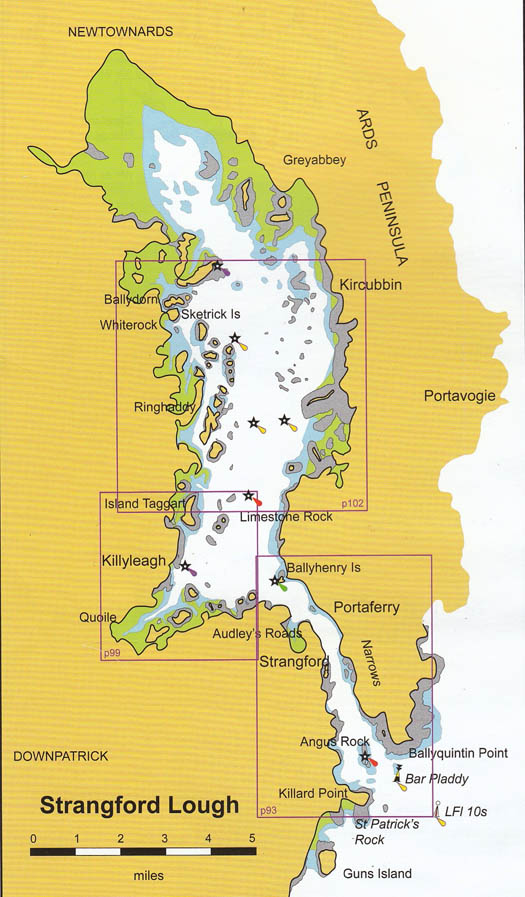
The secret place – despite its substantial size, Strangford Lough remains a mystery to a surprisingly large number of sailors. Courtesy Irish Cruising Club

Strangford Lough's western shore provides tantalising glimpses of sea and islands, usually with boats moored in a snug spot. Photo: W M Nixon
But even when you arrive at the lough by this much-preferred option of being on a boat, there's still that slight sense of intruding on a private place. While Portaferry on the east side of the narrows may present a traditional welcoming façade, and Strangford village to the west is its own charming little self, of the other towns on the lough only Kircubbin halfway up the eastern shore has anything vaguely resembling a waterfront. The lough's biggest township, Killyleagh on the west shore, may have a modern recently-developed waterfront. But that's a private enterprise thing, the town's main street is at some remove from the shore, while other urban centres in the Strangford Lough area such as Downpatrick, Killinchy, Comber, Newtownards and Greyabbey may be near the sea, but they're not of it.
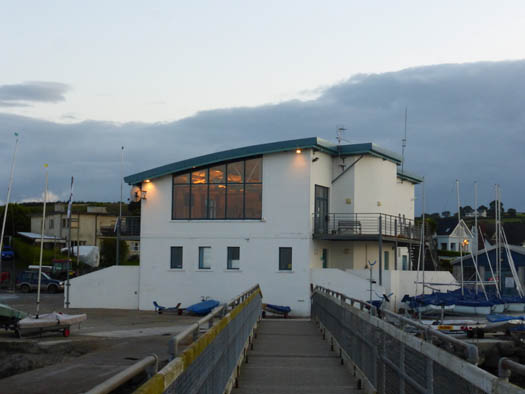
The lough's premier club is the Strangford Lough YC at Whiterock, where this "new" building has been serving members' needs for a dozen years now. Photo: W M Nixon

The view from within. Though the SLYC building may present a utilitarian appearance, its main room is successfully multi-purpose as lounge, dining room and bar, and the view from it is of a comfortable anchorage ready for sailing. Photo: W M Nixon
Yet the lough is home to hundreds of boats, serviced both by private facilities and something like eleven different boat, yacht and sailing clubs. But most of them are along that complex western shore where, in choice locations, the big landowners who had made their money in Belfast's boom days from 1850 to 1912 were so keen to preserve their privacy that they made sure there were no road signs on the few narrow public roads approaching their substantial houses near the shore.
Some years ago, there was an official attempt to liberalise this with a sprinkling of signs, but a visit this week showed that many of them had somehow disappeared, or become invisible under the verdant growth which is fundamental to this heart of the County Down. So more than a smidgin of local knowledge is needed if you wish to access the sailing in this maritime wonderland. But if you can do so, the sport is wonderful if racing around islands and in wayward yet manageable currents is your thing, while there's enough open space in mid-lough to provide a clear venue for major open events, even if it can involved a bit of a sea trek from the shore base at some hidden club.
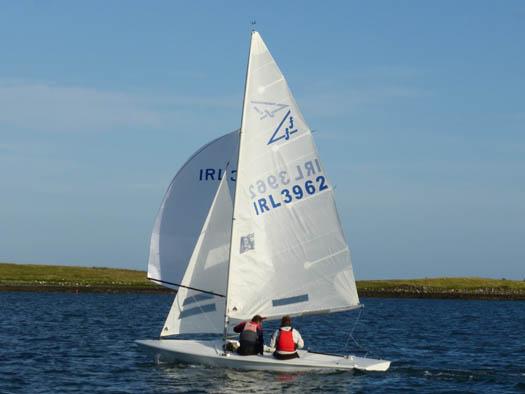
A Flying Fifteen in action at Whiterock off Strangford Lough YC, which has produced F/F Champions to world level.
The active sailing scene in Strangford Lough has produced champions to world level over the years, most notably in the Flying Fifteen class where Strangford Lough sailing surnames such as Carson, Brown, Andrews and McCann have been inscribed on the top trophies down the decades. Thus there's a sense of history in the making with this year's Irish F/F Championship being staged in six days time from August 22nd to 24th by Portaferry Sailing Club at the southeast corner of the lough, where it will be interesting to see how far north they have to go in order to get clear of the fierce tides which flow close past the club's headquarters near Portaferry Marina beside The Narrows.
Meanwhile, this week we'd the chance on Strangford Lough to suss out the racing in two classes which may seem very different, yet each emerged from a clearcut initial requirement which now seems very remote.
The River Class boats at the lough's premier club, Strangford Lough YC at Whiterock on the west shore near Killinchy, really are the area's best kept secret. This is quite an achievement in an ultra-private place like Strangford Lough. Everyone involved with the Rivers knows so much about them that they assume the rest of the world does too. But surprisingly few outsiders know that in the inner reaches of Strangford Lough, they race a class of handsome Alfred Mylne-designed 29ft one design sloops which yield to no-one for classic good looks.
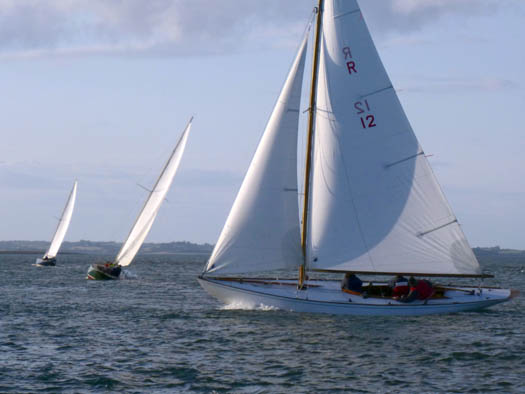
The Mylne-designed 29ft River Class combine classic good looks with real sailing power. Photo: W M Nixon
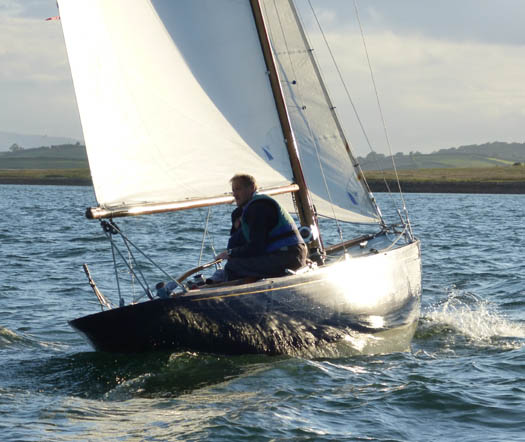
As usual, River Class champion Kenny Smyth has to look astern to see how the opposition is doing. Photo: W M Nixon
Their origins date back to 1919, when some northern sailing people started exchanging ideas about the need for an easily-handled simple sloop "which could be sailed by a man and his daughters". At first glance, this seems like a welcome and liberal requirement, fuelled by the emergence of the suffragette movement seeking votes and rights for women. But in fact, it's the bleakest design spec you ever read. The Great War of 1914-18 had resulted in the deaths of so many young men from the north of Ireland, with scores of them boat enthusiasts who had been active sailors before its outbreak, that the only way the sport could resume in any meaningful way was by moving on from the labour-intensive gaff rigs, jackyard topsails and multiple headsails of the pre war days, on into a simple rig which faced the harsh new reality.
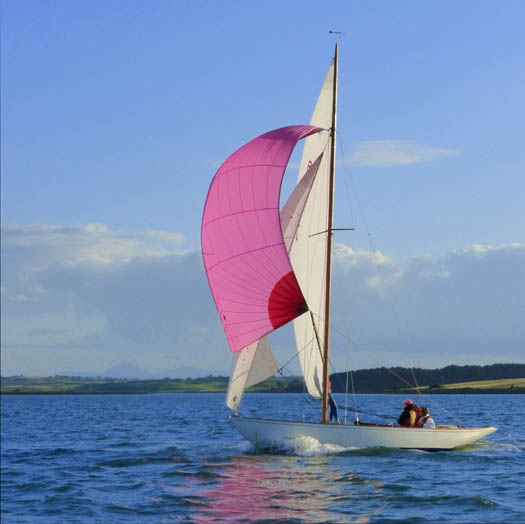
The essence of Strangford Lough – a River Class sloop sailing well, and the timeless view beyond across County Down to the Mountains of Mourne. Photo: W M Nixon

If dodging tides by going close inshore is your thing while using every little twist to the wind, then racing Rivers on Strangford Lough is just for you. Photo: W M Nixon
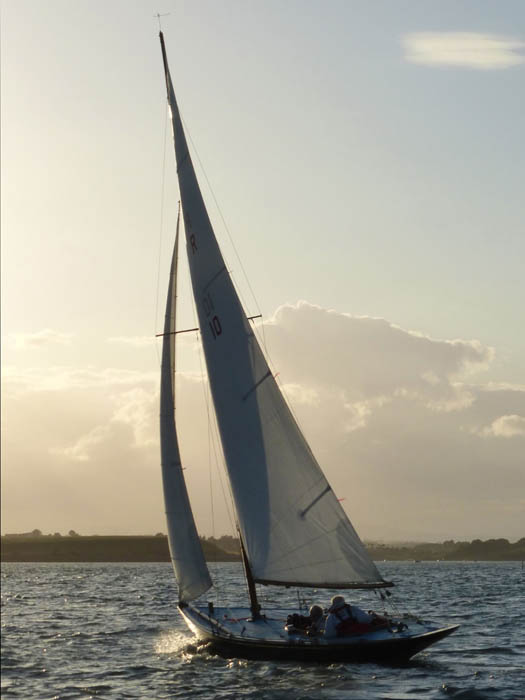
In harmony with her surroundings, a River Class sloop makes her elegant way afloat. Photo: W M Nixon
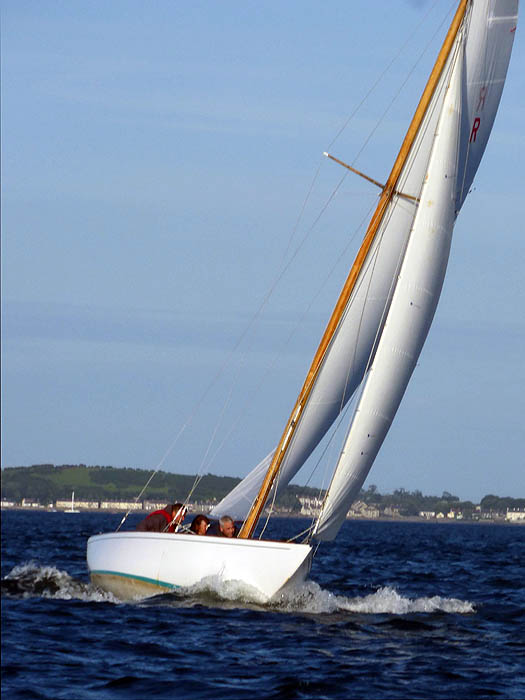
When there's a bit of bite to the breeze, it's impressive how much power the conservatively-canvassed River Class sloops can develop. Photo: W M Nixon
But though the rig may have spoken volumes – it's believed to be the first Bermudan-rigged one design – there was no way that the great Alfred Mylne, the man who reputedly drew the lines of Britannia in 1892-93 as a trainee naval architect in G L Watson's Glasgow office, was going to design anything other than a good-looking boat. Admittedy, with her cockpit well aft, there can be times when a River seems to sit on her stern if her crew are more interested in comfort than boat trim. But when she's sailing on her designed lines, she's a joy to behold, and with her heavy but harmonious hull, she can carry her way in impressive style, making tacking a nicely judged and elegant manoeuvre if it's done right.
In all, a dozen Rivers have been built, most of them before 1923, while the class started racing in 1921. At first, they shifted their racing venues between Belfast Lough and Strangford Lough, as the owners were mostly members of Royal Ulster YC at Bangor. But from time to time they liked to moor their boats off their shoreside big houses on Strangford Lough, usually with their estate gardeners being roped in for additional duties as boat delivery crews sailing between the two loughs along the often rough North Channel coast of the Ards Peninsula. The very thought of it might easily turn anyone into a firebrand revolutionary.
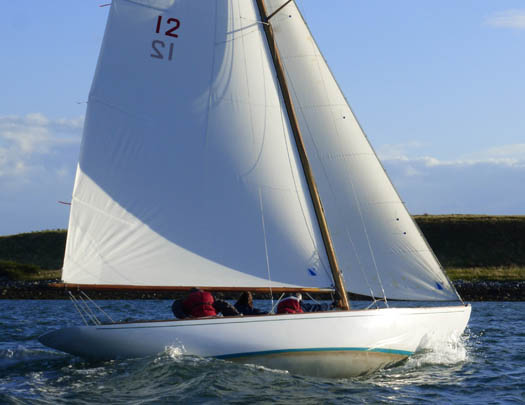
The River was designed by Alfred Mylne in 1920, and shows some family resemblance to the Mylne-designed Dublin Bay 21s (1902) and Dublin Bay 24s (1937), while still being very much an individual in her own right. Photo: W M Nixon
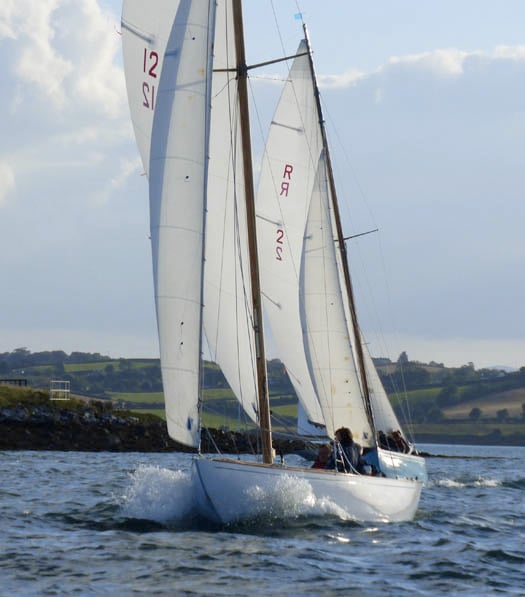
Thanks to an adequately-sized rudder of only moderate rake, it is possible to race the Rivers at close quarters with confidence. Photo: W M Nixon
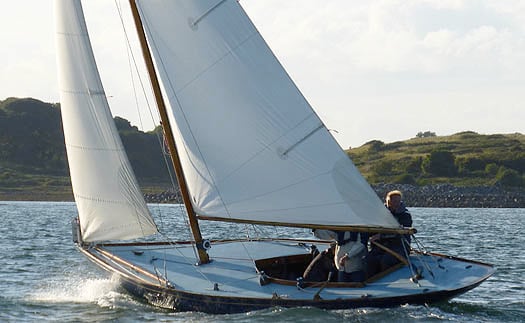
As the Rivers don't set genoas, the correct trim of the little jib is absolutely key to racing success. The class has strict rules about replacing sails only as a group in order to maintain one design performance. Photo: W M Nixon
Be that as it may, gradually the focus moved completely to Strangford Lough, and for a while the class had such a preponderance of aristocratic owners that you could be forgiven for thinking it was P G Wodehouse's take on yachting. Typical were Lord and Lady Londonderry (they pronounced its London-dree), with their seat at Mount Stewart on the lough's eastern shore.
They argued so much aboard their River that they had to get another one so that Lady Edith could race against her husband. In the late 1930s, when she began to favour a policy of Appeasement with the resurgent Germany and flirted with Hitler's Nazis, she invited the Nazi big cheese von Ribbentrop to stay at Mount Stewart and sail with her in a race off the house aboard her River, which was duly T-boned during the event by her husband in his boat.
That was about the height of international excitement and celebrity for the Rivers. By the end of the 1930s, the class had become based at Whiterock with the new Strangford Lough Yacht Club, and the only time they subsequently emerged blinking into the outside world was in 1951 when they sailed as a group to race in the Festival of Britain Regatta Week on Belfast Lough, where the supreme champion by a mile in the River racing was the young Barry Bramwell sailing his family's boat Roe. His subsequent stellar sailing career included winning many dinghy championships, and he skippered a boat for Ireland in the Admiral's Cup.

Although the River Class have not sailed outside Strangford Lough since 1951, their close competition at home has produced some notable performers in other boat types. Photo: W M Nixon
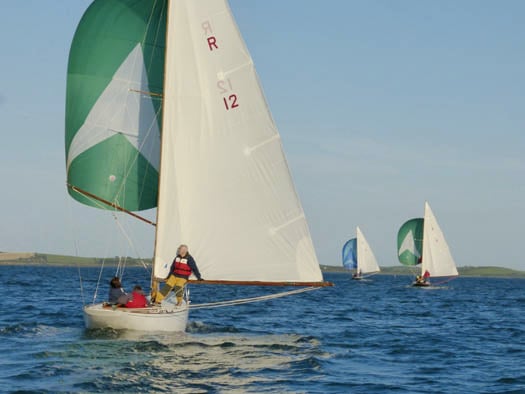
Rivers on the run, and looking very handsome with it. The class has decided that having a kicking strap would not be in the spirit of the design, so having a crewman seated on the boom on a dead run is standard practice. Photo: W M Nixon

With the crew up forward under the deck, and only the helmsman aft in the cockpit, Brian Law's Uladh (10) is perfectly trimmed for best performance to windward. Photo: W M Nixon
The Rivers meanwhile returned home after the Festival Regatta Week, and since 1951 the nearest they've ever got to the open sea is the annual visit to the time-honoured Narrows Regatta between Portaferry and Strangford for a few days in July. Otherwise, they might sometimes be seen at local regattas at the Quoile, Killyleagh and Kircubbin. But for the most part, they stay in stately seclusion at Whiterock and enjoy a compact annual racing programme. This may seem to be only relatively few races to those from other hyper-keen local one design classes. But after 93 years, the Rivers have become such an integral part of the fabric of sailing at Whiterock, and such a central part of community and family life for those involved, that you don't need a huge number of races for each season to be a success, what's needed is the savouring of the moments afloat on a summer's evening, and then an analysis of each race in loving detail in the friendly clubhouse afterwards.
With the GP 14 Worlds coming up on Strangford Lough this past week, there was an ideal opportunity to contrast two forms of sailing there. I'd already tried to get some River Class photos on an evening earlier in the season by signing up to sail as fifth hand aboard Brian Law's Uladh (the von Ribbentrop boat). But when we all assembled, it emerged - in typically Strangford Lough style - that the helmsman was delayed by the need to get his wife and daughter's vintage horsebox through its MOT test, so I was stuck on the Tiller That Von Ribbentrop Held.
Despite that, the boat was a joy to sail in a light summery shirt sleeves breeze, but it resulted in damn all worthwhile photos on the disk. So this week, Brian and another River owner Kenny Smyth, Vice Commodore SLYC, arranged for Chris Boston, whose hobby is being a sort of Honorary Boatman at Whiterock, to take me out to buzz around the racing fleet on an August evening with a decent though fading northwest breeze, and Chris did a super job.
My camera is just a clever little Lumix, which is a Leica lens with a sort of digital Box Brownie stuck on the back. So please excuse the fuzzy telephoto shots, but the photos speak for themselves – the Rivers are good looking classic boats which provide great sport. These days, the Smyth brothers Kenny and Graham are setting the pace, which suggests sailing enthusiasm of a high order. Their day job is running the characterful little boatyard immediately south of Whiterock, an establishment created by their legendary father Billy who introduced his family to cruising through extensive ventures in the former Manx fishing boat Aigh Vie (see this blog on 29th March 2014). Whatever way Billy Smyth did it, he imbued his sons with such enthusiasm that they can spend their working day being busy fixing somebody else's boat, then go out and sail their own boats with equal dedication in the weekly evening race. And they're more than generous with helpful tips to their opponents on tactics and tuning.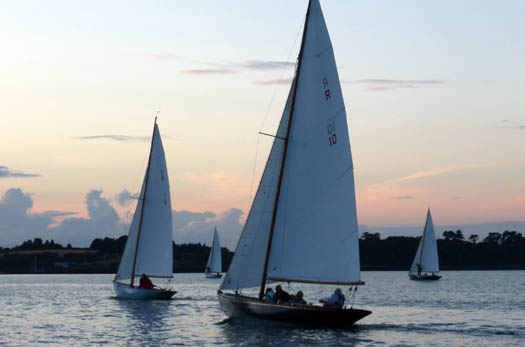
When they talk of "twilight racing" in the River Class, they really mean it......Photo: W M Nixon
Having spent an entertaing and very complete evening with the classics that were designed so that they could be sailed by a man and his daughters, next morning found me contemplating a hundred dinghies to a 14ft design which was originally envisaged as a useful and versatile little boat to provide "affordable fun afloat for Pa, Ma and the kids".
Like the River, the GP 14 emerged in a post war situation, but in 1949 the mood after World War II (1939-45) was much more egalitarian than it had been in 1919. The General Purpose 14 was the brainchild of Teddy Haylock, the Editor of Yachting World magazine in London, and it was one of the first in a series which became the YW Build Her Yourself boats, mostly designed by Jack Holt with DIY plywood kits supplied by Bell Woodworking Co.
Haylock still carried his wartime title of Group Captain E F Haylock after a "good war" with the RAF, but he had a very clearcut view of how things should go in peacetime. If his projects sometimes seemed to be delivered in a slightly patronising tone, there's no doubt his heart was in the right place, even if some of his posher advertisers weren't at all pleased by his glossy magazine devoting so much energy to people who hoped to self-assemble their own boats rather than buy a complete and expensive one from an established yacht builder.
To say that the GP 14 succeeded beyond anyone's wildest dreams is under-stating the case. Though the 14,000-plus boats built worldwide have been used for general purposes, they're primarily racing boats these days, and it was this which brought a hundred of them to the well hidden East Down YC in behind Island Taggart on Strangford Lough's west shore just north of Killyleagh.
Back in 1970, most folk thought that just about every possible sailing club site on the shores of Strangford Lough had been earmarked and developed. But the founders of EDYC discovered this place, which was accessible by land only along a narrow unpaved track going so close to the edge of a farmyard that it almost goes through it. In those days before 4X4s were ubiquitous, you really did need a Landrover to get to the new waterfront location with any certainty. But over the years the club has expanded its clubhouse and its facilities ashore with an extensive dinghy park, while the keelboat fleet linked to the club includes former Commodore Jay Colville's First 40 which took part in this year's ICRA Nats in Dun Laoghaire.
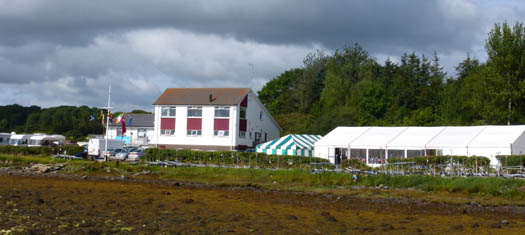
East Down YC, venue for the GP 14 Worlds 2014. Photo: W M Nixon

Somehow or other, the founders of EDYC in 1970 managed to shoehorn their substantial clubhouse with its large dinghy park into a previously unused waterfront setting accessed via this narrow lane. Photo: W M Nixon
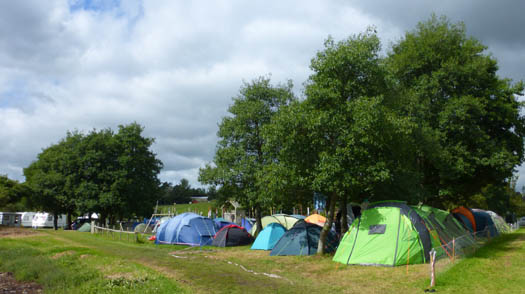
All that GP 14 sailors require is somewhere to pitch their tent........Photo: W M Nixon
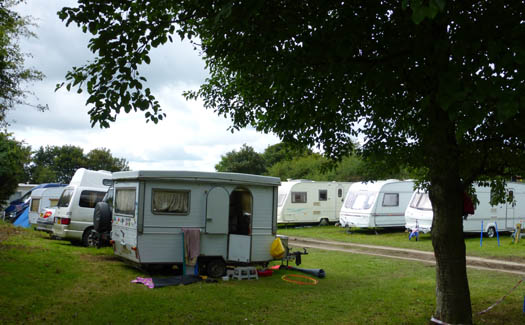
...or park their 'van. Photo: W M Nixon

Graham Wright of EDYC gallantly took on the challenge of chairing the Organising Committee for the GP 14 Worlds 2014 with just two years to go to the off. Photo: W M Nixon

The kind of headlines that any organisers dread. Yet EDYC were quite rightly so confident about their proper handling of the weather problems that they subsequently displayed this newspaper spread in the main marque. Photo: W M Nixon
Taking on a Worlds is a formidable challenge for any club, and when it's the Worlds of a dinghy class which is as important in Ireland as the GP 14, the pressure is greater still. It was as recently as 2012 that East Down was approached by the Irish GP 14 Association as they realised other avenues were being closed off in their search for a willing club for their allocated staging of the Worlds in 2014, and the club deserves an award for courage in taking it on, setting up an Organising Committee under Graham Wright and getting the show on the road.
I'd a telling instance of just why the GP 14 is so relevant recently while heading through Youghal, where three dinghy masts were visible above a harbourside wall. On the other side of the wall was one of those little mud-filled docks which are such a feature of Youghal's waterfront, and sitting serenely on the mud were three GP 14s.
What else could they have been? As I was to discover at EDYC, the GP 14 is central to building up the sailing club at Youghal, and at many other clubs all round the country too. While some members may try more glamorous boats from time to time, the GP 14 ticks most boxes in terms of versatility while setting a spinnaker, having an effective class structure, and providing racing at all levels.
My own links to the class go back to the 1960s when the sailing club at Queens University in Belfast suddenly found itself supplied with funds for a new boat or two provided the boats were built within a specified time. Although club captain, I was already a dedicated keelboat man except for the annual foray into Fireflies racing against other colleges in Dun Laoghaire and England & Wales. In other words, I knew nothing. However, our Honorary Secretary Mike Balmforth was a very switched on guy who had built his own Enterprise with his father. But as QUB already had a couple of old GP 14s, he soon decided that we could get the boats built on time – and they'd be GP 14s as required - by a relative newcomer to boatbuilding called Gerry Duffin, a former housebuilder and carpenter who had his workshop in East Belfast and was starting to fulfil his dream of building boats.
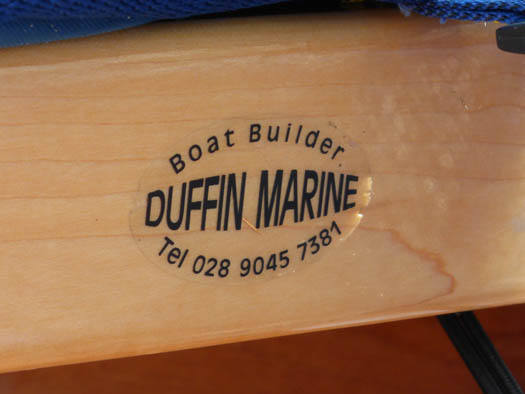
The sign of success – the home firm builds the best GP 14s in the world. Photo: W M Nixon
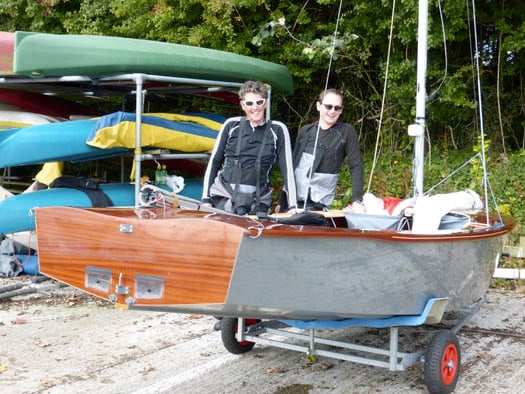
The "Duffin dip" in the transom of the newest boat for the Lough Foyle fleet. Photo: W M Nixon
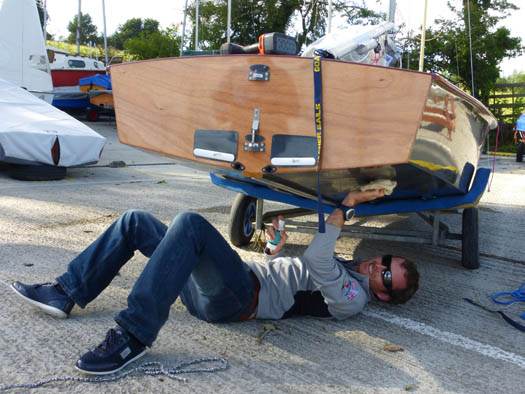
"If you want to be sure it's done properly, then you have to do it yourself" Top contender Ian Dobson putting in some work on the hull finish. Photo: W M Nixon
One rainy day we went across town in Mike's rickety Austin 7 (its wooden frame was supported by Spanish windlasses utilising electric cable instead of rope), and there in the shed was the first of the new boats. It was a very old shed, and there were several leaks which prompted Gerry to quip that he really should get the builders in. But to our young eyes, there was nothing to see but this lovely new GP 14, an early product of a line which continues to the present day, for at East Down YC this week all the main contenders, and indeed the majority of the fleet, were Duffin built, with Duffin Marine for many years now being run by Gerry's son Alistair.
Like the Smyth brothers up at Whiterock, his enthusiasm is almost certifiable, as he not only builds the best GP 14s for everyone else, but he also races keenly with the class. And though the rules are strict, he is always trying to find ways of innovating his products, which are more like collector's furniture than boats.
In recent years, he has tried to persuade the class to let him take out most of the transom in modern style, but when an open transom was declared verboten, instead he introduced the "Duffin dip" in the afterdeck. When asked why, his answer was that he just keeps trying to reduce weight. Whatever, people certainly love his boats. I was at East Down briefly in late afternoon on the layday on Wednesday, and though there were few folk around, down at the end of the dinghy park was top contender Ian Southworth beavering away at his beloved Duffin boat.
The mood was distinctly relaxed with the club and the class well recovered from he unexpected wall-to-wall attention they'd received on the Monday. A couple of nasty squalls – yet another by-product of the slow progress of former Hurricane Bertha across northwest Europe – had resulted in between ten and twenty boats having some difficulty in coping with being capsized. But the Championship safety team were handling it competently when it was declared an Emergency Situation by some Powers That Be. Almost immediately those narrow roads and single track approaches to the club were jammed with ambulances and a fire brigade as helicopters gyrated overhead.
While some newspapers sought only to have shock headlines, it has to be said that when the scale of the over-response became evident, it was heartening to see how the better strands of the media responded to it all with an intelligent and friendly interest in what was going on. They were fascinated by how an event which was classed as a World Championship was being staged, and staged so effectively too, at the end of a tree-lined single-track lane in remotely rural County Down. In the end, the clear egalitarian nature of GP 14 racing and the calmness of the people involved reflected very well on the image of our sport. And as for the multiple rescue and emergency services, they had all the benefits of a "for real" exercise which might prove to be very useful in the unlikely event of a passenger jetliner ever coming down among the islands of Strangford Lough.
The atmosphere may have been serene in the late afternoon of the layday, but next morning with three races scheduled in a brisk nor'wester, the club compound was hectic enough for anyone. And the layday did the trick – as one of the International Jury remarked, it is very unusual at any Worlds to see the entire fleet put to sea two thirds of the way into the event, but they poured down the slip and away out round the island, and at the end of it there wasn't a boat left ashore.
But by that time I'd had every opportunity to observe the spirit of the GP 14s, and it is formidable. Ireland has a great record in the class, with Bill Whisker of Ballyholme becoming a World Champion, while others like Paul Rowan of East Antrim and Pat Murphy of Clontarf were in the international frame for years.
Yet these days the class is as keen as ever in encouraging new blood and establishing a firm foothold at new clubs. That glimpse of a nascent GP 14 class at Youghal well illustrated the point, and it was Norman Lee who told the story. I'd spotted the famous vintage camper van which is the campaign base for GP 14 legend Norman Lee of Greystones, who is crewed by his brother Ken and supported by Norman's wife Una and their two collie dogs - dogs on campaign are very much a GP 14 thing.
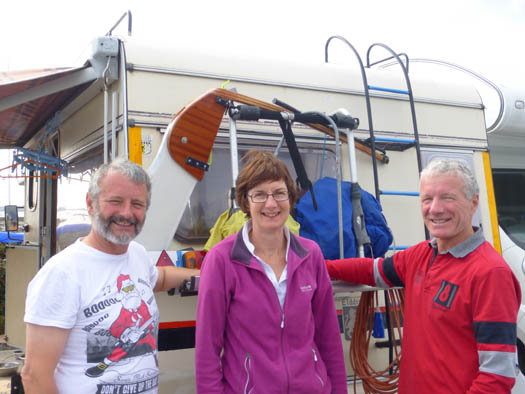
The Lee team from Greystones with their vintage campervan are Ken (left), Norman (right) and Una. Photo: W M Nixon
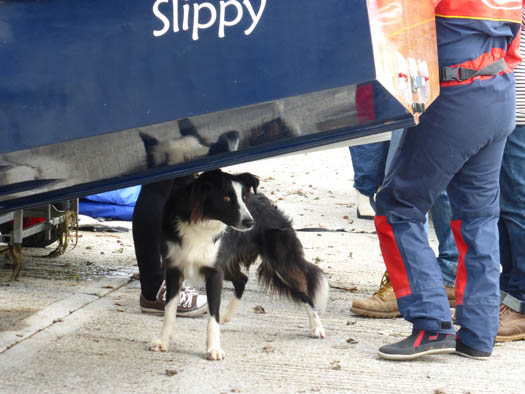
If you're going to have a GP 14.........Photo: W M Nixon
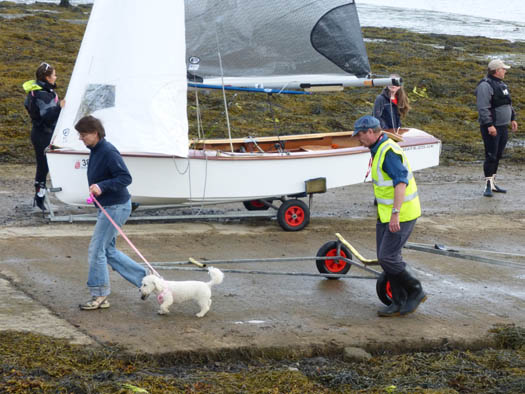
....then you have to have a pooch. Photo: W M Nixon

...and while most breeds are allowed, a collie variant is preferred. Photo: W M Nixon
The Lee equipage was in fine form, having taken a useful second in one of Tuesday's races, but as soon as I mentioned the presence of the Geeps at Youghal, all that was forgotten as Norman enthused about the growing club there, and what he and the class are doing to get Youghal's GP fan Adrian Lee (no relation) and his group further down the road.
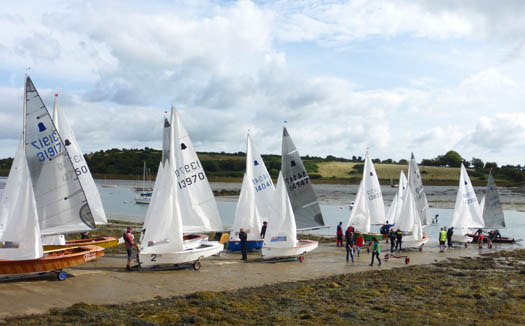
Getting a hunded boats away is a formidable challenge..... Photo: W M Nixon
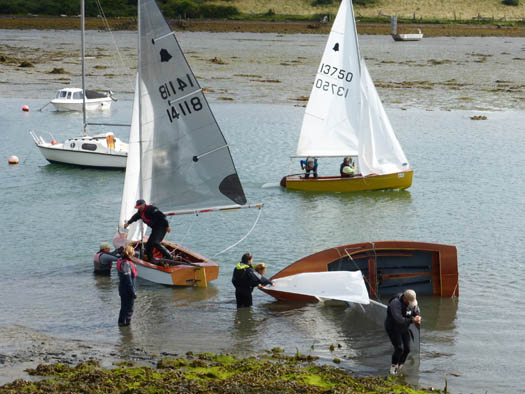
....and the last thing you need is somebody deciding last minute adjustments are essential.......Photo: W M Nixon

....when they're still joining the queue at the top of slip. Photo: W M Nixon
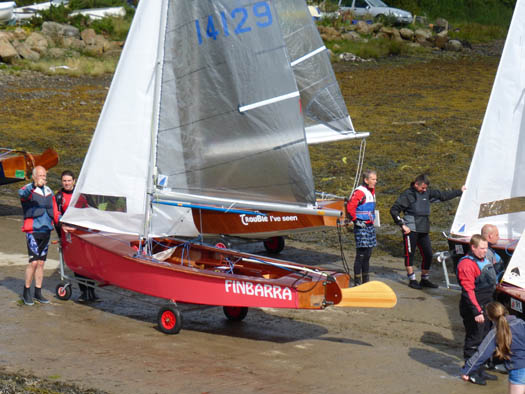
"Don't these guys holding us up realise that they're delaying a whole line of renowned international athletes.....?" Photo: W M Nixon
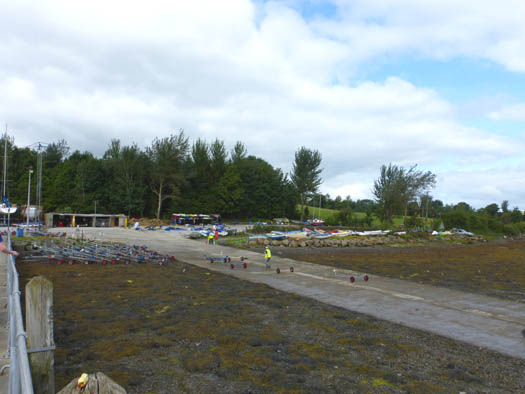
Suddenly, they're gone – every last one of them. This is one very keen class. Photo: W M Nixon
Or more accurately, further up the river. Norman and other GP 14 sailors are fascinated by the possibilities of the mighty Blackwater River which reaches the sea at Youghal. Already, they have had a trial distance sail from the estuary right up to Cappoquin, and this has fired them up so much that they're going to make it a major event when they repeat it in the last weekend of August in order to give Youghal SC a proper re-launch. Their enthusiasm has so fired up others that top GP 14 racers like Ger Owens from Dun Laoghaire have said they'll go, as have crews from the growing fleets on Lough Foyle, which is wellnigh as far as it's possible to be from Youghal without leaving Ireland.
It may all seem a bit far-fetched. But believe me, when you're in a large dinghy park at the end of a small farm track in the depths of County Down, and when the event photographer has just gone aloft in a small aircraft because that's the best way to get snaps of a major dinghy event out in the middle of Strangford Lough, then long distance dinghy sailing events from Youghal to Cappoquin seem eminently feasible.




























